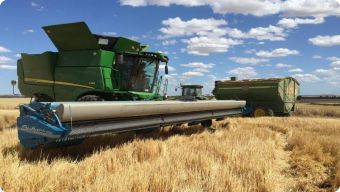they’re cheaper on fuel, easier on harvesters and process more grain than straw, and may fit the bill in no-till, but they’re not for everyone.
Stripper front fits no-till bill
That’s the feedback from a series of demonstrations of a Shelbourne Reynolds stripper front run by the east coast distributor, NSW Deere dealer Hutcheon and Pearce that took in southern NSW and Victoria.
Farmers from Victoria’s Streatham district watched the front in action stripping an Oxford barley crop last week.
Fitted with a rotating front drum with six rows of stripping fingers rather than a standard draper style feeder, the Shelbourne has been extensively used in rice for many years in Australia but is making inroads into conventional cereal crops with interest coming from no-tillers wanting to maximise the preservation of standing stubble.
Hutcheon and Pearce sales consultant Myles O’Kane said the fronts were a rice harvesting favourite as they minimise the amount of trash going through the header which in rice often still sports shades of green.
“The Shelbourne has a combing action with fingers guiding the crop into a keyhole which strips the head off,” he said.
The hydraulically driven rotating stripper drum has six rows of stainless steel combing fingers that are fitted in replaceable 60cm sections.
Mr O’Kane said the drum was “designed to run as slow as possible at around 450 to 500 rpm”, was designed for cereal crops and would suit no-till systems.
“It is a cereal front and you look at the machine as a tool in your cropping system - it is not a direct replacement for a draper front - it is another purpose built tool.”
The demonstration at Streatham saw a Shelbourne XCV42 (42’ / 12.8 m) designed to suit 12.2/36 metre CTF application, fitted to an Emmett’s supplied John Deere S680. The demo program has generated keen interest according to Mr O’Kane.
“Everyone has been pretty excited by the results it is leaving – they like the idea that you are not putting all the straw through the harvester and throwing it out the backside,” he said.
“The challenge for no-till is how to get through it during sowing in wetter areas the straw may pose a bit of a challenge, but in the drier areas in the northern states, the no tillers have got the soil compound working properly and the stubble is breaking down quickly and they can get through it with disc planters.”
Streatham farmer and Vic NoTill member, Scott Blurton said he was interested in checking out any tool that could fit the no-till system he has been converted to for about six years.
“It certainly provides more ground cover - obviously that may pose some problems with the amount of stubble left but it is a good opportunity to see how it could fit, or if it does fit or doesn’t fit a no-till system.”
He said the idea was to keep the longer straw off the ground.
“How you deal with the straw is the thing - standing straw is the key, the stuff on the ground is the stuff that can cause problems,” he said.
“It’s always about exploration and we are always trying to push how far we can go with no-till.”
The XCV range comprises three centre mounted machines, the XCV42, XCV36 and XCV32, all fitted with a three section stripping rotor and two section auger.
New features in the range include a spring loaded pivoting adaptor plate system which work with spring loaded gauge wheels for contour following ability.



